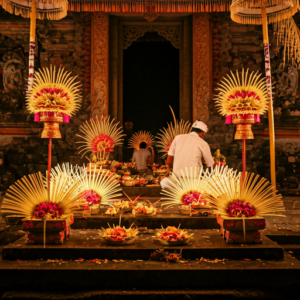In the lush, verdant landscapes of Bali, where emerald rice terraces cascade down volcanic slopes and ancient temples stand as silent guardians of tradition, purification rituals are more than mere ceremonies—they are the heartbeat of Balinese spiritual life. These sacred practices, deeply rooted in Balinese Hinduism, represent a profound connection between the physical and spiritual worlds, offering a window into a culture that views cleansing as an essential path to harmony, balance, and spiritual well-being.
The Philosophical Foundations of Purification
To understand Balinese purification rituals, one must first grasp the fundamental Balinese philosophical concept of Tri Hita Karana—a holistic worldview that emphasizes harmony between humans, nature, and the divine. This philosophy sees purification not as a singular act, but as a continuous process of maintaining balance and spiritual clarity.
In Balinese belief, impurity—or noda—is not just a physical state but a spiritual condition that can accumulate through negative thoughts, actions, and environmental interactions. Purification rituals are therefore a means of restoring rta, the cosmic order that governs existence. These ceremonies are not simply about cleansing the body, but about realigning one’s entire spiritual ecosystem.
The Spectrum of Purification Rituals
1. Melukat: The Water Purification Ceremony
Perhaps the most visually striking of Balinese purification rituals is Melukat, a water-based cleansing ceremony that can take place in sacred springs, rivers, or specially designated temple pools. Participants immerse themselves in water while priests chant mantras and sprinkle holy water, symbolically washing away spiritual impurities.
Each Melukat has its own unique characteristics. Some are performed to mark significant life transitions, others to heal from spiritual or physical ailments, and some as regular spiritual maintenance. The ritual typically involves:
- Wearing traditional white or ceremonial clothing
- Presenting offerings (canang sari) to the gods
- Receiving holy water from a pemangku (temple priest)
- Performing specific movements and prayers
The water used in Melukat is not merely H2O, but a living, sacred entity believed to carry divine energies capable of spiritual transformation.
2. Mesangih: The Tooth Filing Ceremony
One of the most profound and symbolic purification rituals is Mesangih, or the tooth filing ceremony. Traditionally performed when an individual reaches puberty, this ritual represents the control of human negative traits such as anger, greed, and jealousy.
During the ceremony, a priest files down the six upper front teeth—symbolically removing animalistic characteristics and preparing the individual for adulthood. This painful yet deeply meaningful ritual signifies:
- The transition from childhood to adulthood
- Spiritual and emotional maturity
- The ability to control one’s base impulses
- Readiness to take on social responsibilities
Despite its challenging nature, Mesangih is considered a critical rite of passage in Balinese culture, representing personal and spiritual growth.
3. Melasti: Community-Wide Purification
Melasti is a massive, island-wide purification ritual that occurs just before Nyepi (the Balinese Day of Silence). Entire communities dress in traditional white and yellow attire, carrying sacred artifacts to the sea, rivers, or lakes to be ritually cleansed.
This spectacular ceremony involves:
- Processions of villagers carrying temple objects
- Elaborate offerings to the gods
- Collective prayers and chants
- Symbolic cleansing of sacred artifacts
Melasti represents not just individual purification, but collective spiritual renewal, reinforcing community bonds and shared cultural identity.
The Role of Offerings in Purification
No discussion of Balinese purification would be complete without exploring canang sari—intricate, handmade offerings that are fundamental to the spiritual practice. These small, meticulously crafted baskets made from coconut leaves and filled with flowers, rice, and other symbolic items are placed everywhere—on sidewalks, in temples, outside homes—as constant acts of spiritual cleansing and gratitude.
Each element of the offering carries deep symbolism:
- White flowers facing east represent Vishnu and purity
- Red flowers facing south symbolize Brahma and creative energy
- Yellow flowers facing west represent Shiva and transformation
- Green or blue flowers facing north represent spiritual protection
These offerings are not static objects but dynamic spiritual communications, continuously rebalancing the relationship between humans, nature, and the divine.
Modern Challenges and Cultural Preservation
In an increasingly globalized world, Balinese purification rituals face significant challenges. Younger generations, influenced by modern lifestyles and global culture, sometimes view these practices as outdated or inconvenient. Yet, there’s a strong counter-movement of cultural preservation, with many young Balinese actively recommitting to these traditions.
Cultural leaders and spiritual guides are finding innovative ways to make these rituals relevant, explaining their psychological and communal benefits beyond traditional spiritual interpretations. They emphasize how these practices provide:
- Stress reduction
- Community bonding
- Cultural identity maintenance
- Mindfulness and spiritual connection
Personal Transformation Through Ritual
What makes Balinese purification rituals truly extraordinary is their holistic approach to human experience. They do not see spiritual cleansing as a rare, dramatic event but as a continuous, integrated practice of daily life.
A Melukat is not just about washing away bad energy; it’s about consciously choosing spiritual growth. A tooth filing ceremony is more than a physical modification; it’s a profound statement of personal evolution. An offering is not merely a religious obligation but an ongoing dialogue with the universe.
Conclusion: A Living Tradition
Balinese purification rituals offer the world a remarkable model of spiritual practice—one that sees cleansing not as a punitive process, but as a beautiful, transformative journey. In a world often fragmented by individualism and disconnection, these traditions remind us of our fundamental interconnectedness.
As global citizens, we can learn much from this approach. The Balinese understanding that spiritual and physical realms are intrinsically linked, that personal growth requires continuous effort, and that community plays a crucial role in individual transformation is a powerful antidote to modern alienation.






